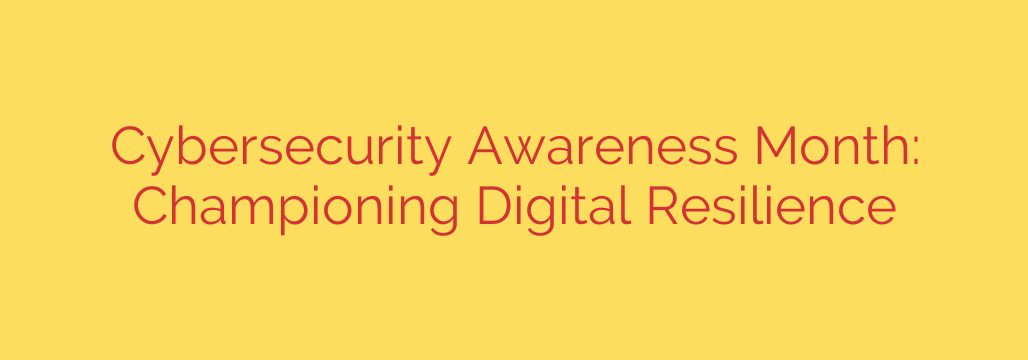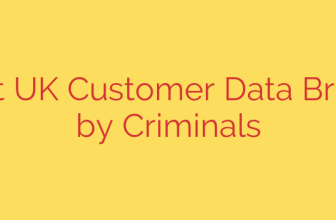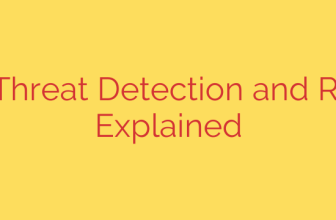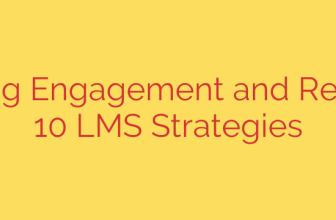
Your Essential Guide to Cybersecurity Awareness: 4 Steps to a Safer Digital Life
In our increasingly connected world, digital security is no longer a concern just for IT experts—it’s a fundamental aspect of our daily lives. From online banking and shopping to professional communications and social networking, our personal information is constantly flowing through digital channels. This makes us all potential targets for cyber threats. Cybersecurity Awareness Month serves as a critical reminder that we all play a role in protecting our digital world.
Building a strong defense isn’t about becoming a security guru overnight. It’s about adopting a few core, powerful habits that significantly reduce your risk. Think of it as locking your doors and windows before you leave the house—simple, effective, and essential. Here are four key actions you can take today to bolster your digital defenses.
1. Master Your Passwords and Use a Password Manager
Your password is the primary key to your digital life. A weak or reused password is like leaving that key under the doormat for anyone to find. Attackers regularly use automated tools to guess common passwords or use credentials stolen from one data breach to access other accounts.
The old advice of creating complex passwords you can barely remember is outdated. The modern, more secure approach involves two key components:
- Create Strong, Unique Passphrases: Instead of a short, complex password like
P@$$w0rd!, use a longer passphrase that is easy for you to remember but hard for a computer to guess. For example,Correct-Horse-Battery-Staple. Make sure every important account has its own unique passphrase. - Use a Password Manager: The single best thing you can do for your password security is to use a reputable password manager. These tools generate and securely store highly complex, unique passwords for every site you use. You only need to remember one master password, and the manager handles the rest. This eliminates the dangerous habit of password reuse.
2. Turn On Multi-Factor Authentication (MFA)
If a strong password is the lock on your digital door, Multi-Factor Authentication (MFA) is the deadbolt. It provides a crucial second layer of security that protects your accounts even if your password is stolen. MFA requires you to provide two or more pieces of evidence to prove your identity before granting access.
Typically, this involves combining:
- Something you know: Your password or PIN.
- Something you have: A code from an authenticator app on your phone, a text message, or a physical security key.
Even if a cybercriminal manages to steal your password, they won’t be able to access your account without that second factor. Enabling MFA on your critical accounts—like email, banking, and social media—is one of the most effective security measures you can take. Check the security settings of your favorite apps and services and turn it on wherever it’s offered.
3. Recognize and Report Phishing Attempts
The most sophisticated security systems in the world can be bypassed if a user is tricked into handing over their credentials. This is the goal of phishing—a type of social engineering where attackers use deceptive emails, text messages, or phone calls to steal sensitive information like passwords, credit card numbers, or personal data.
These attacks are becoming more sophisticated, often using convincing branding and urgent language to trick you into acting without thinking. Be on the lookout for these red flags:
- A sense of urgency or threats: “Your account will be suspended unless you click this link immediately!”
- Generic greetings: “Dear Valued Customer” instead of your actual name.
- Poor grammar and spelling mistakes: A common sign of a fraudulent message.
- Suspicious links or attachments: Hover over links to see the actual URL before clicking. Never open unexpected attachments.
- Requests for sensitive information: Legitimate companies will never ask for your password or full financial details via email.
This threat extends beyond email. “Smishing” (SMS phishing) uses text messages, and “vishing” (voice phishing) uses phone calls to achieve the same goals. The most important rule is to slow down and think before you click or respond. If you receive a suspicious message, report it as junk or phishing and then delete it.
4. Keep Your Software and Apps Updated
Those frequent update notifications on your phone, computer, and apps can seem annoying, but they are vital for your security. Software developers constantly release updates not just to add new features, but to patch security vulnerabilities that have been discovered.
When a vulnerability is found, cybercriminals race to exploit it on devices that haven’t been updated yet. Running outdated software is like leaving a known vulnerability wide open for attackers to walk through.
The best defense is a simple one: enable automatic updates whenever possible. This ensures your devices and applications are always protected against the latest known threats without you having to think about it. For software that requires manual updates, make it a habit to check and install them regularly.
Building a Culture of Digital Resilience
Cybersecurity isn’t a one-time task; it’s an ongoing practice. By integrating these four key behaviors into your digital routine, you transform from a potential target into a strong first line of defense. Share this knowledge with your colleagues, friends, and family to help create a safer digital community for everyone.
Source: https://feedpress.me/link/23532/17176186/cybersecurity-awareness-month-2025








